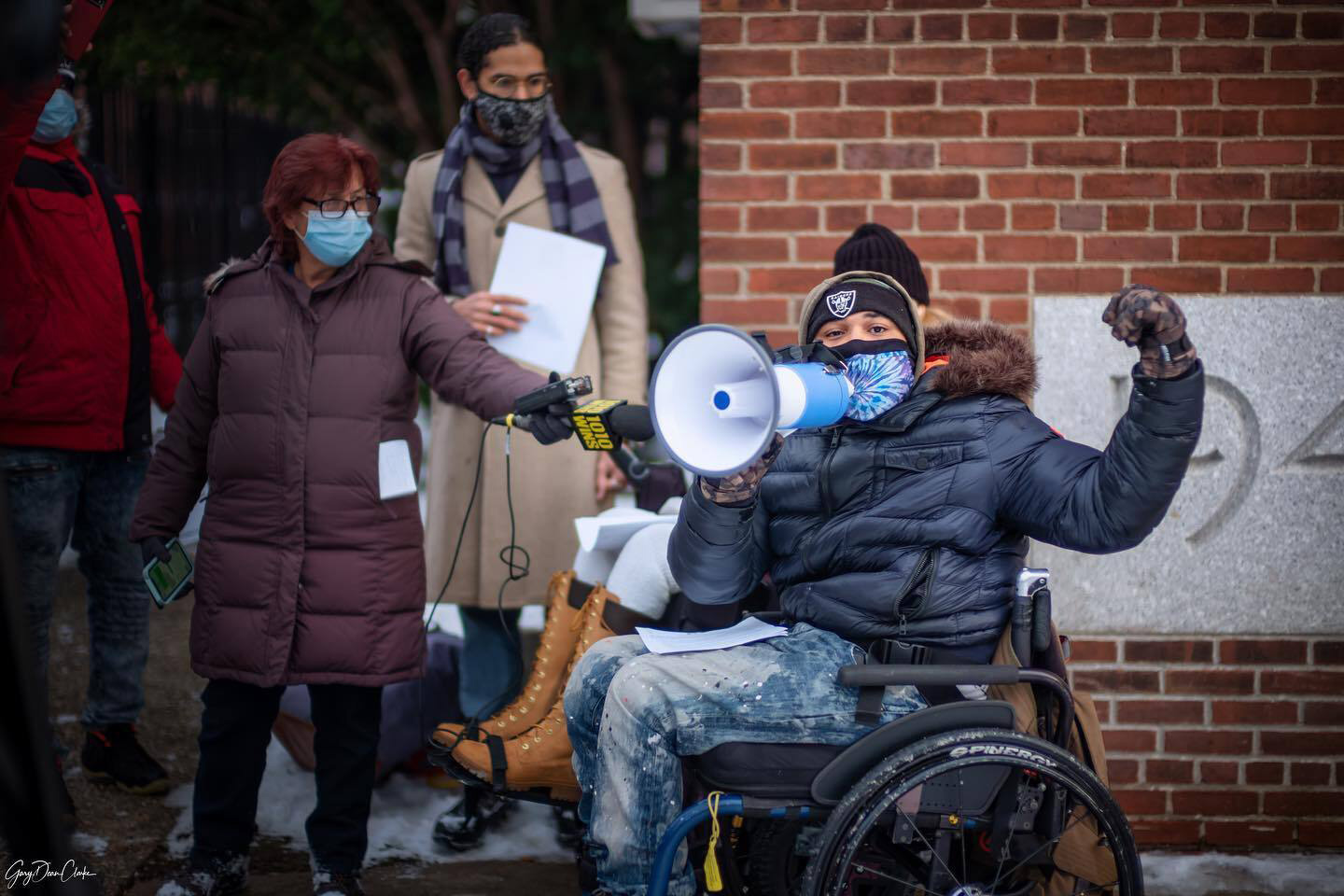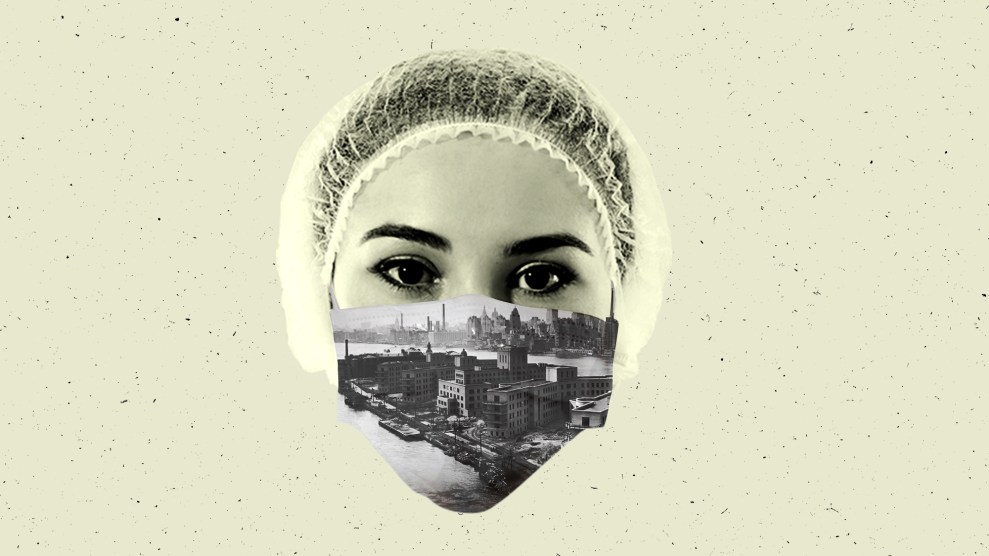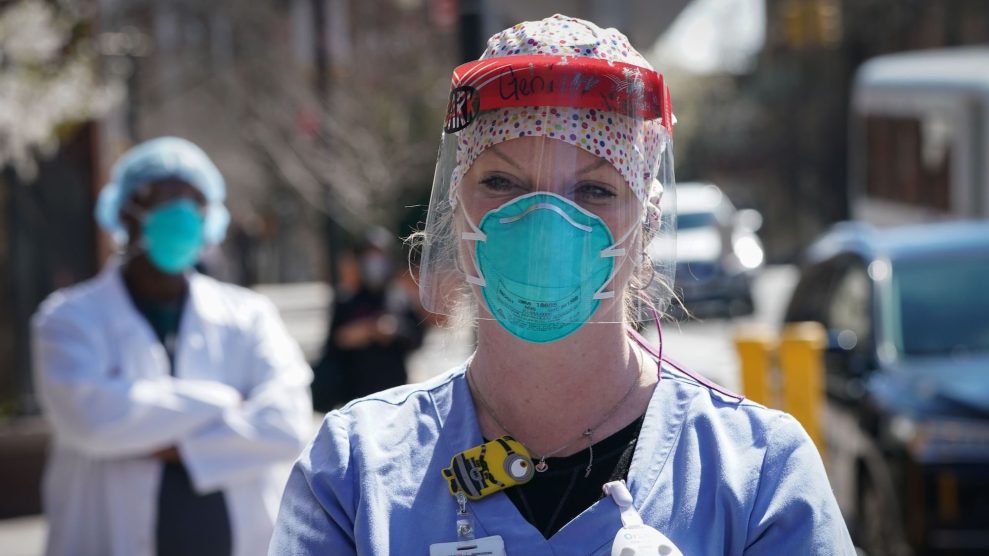On a cold and snowy Saturday in December, three men in wheelchairs slowly rolled up to the tall black gates that separate Coler Rehabilitation and Nursing Care Center from the outside world. They are all physically disabled, range in age from 34 to 66, and rely on full-time care to survive. One of them carried a sign that announced “Nursing Home Lives Matter.” They all call this public nursing facility on the northern tip of Roosevelt Island in New York City home.
Vincent Pierce, a 34-year-old Coler resident who was one of the lead organizers, sat in his wheelchair wearing a bright red beanie and matching red sneakers. Robbed at gunpoint and shot in the neck in 2012, he was left paralyzed from the neck down and has lived in Coler for the past seven years. Before the pandemic, Pierce would visit his family and friends in Newburgh, New York, a town over an hour north of the city, and they would come to Roosevelt Island about twice a month. But since March, he hasn’t seen any of them. It’s been almost a year since he’s seen his 12-year-old daughter. It’s just one of many adjustments for residents inside Coler during a period of time Pierce describes as having been “total hell.” A hell that was made worse after New York City imported COVID patients into his home.
He propelled his wheelchair toward the gate, where a small crowd of a few dozen people had gathered on the other side. A television reporter from Fox 5 stuck her microphone through the bars and asked Pierce when COVID patients first came to Coler.
“I would say around March,” Pierce answered. He’s mellow and soft-spoken. More often than not there’s a smile playing around his lips. “They told us they weren’t bringing COVID patients in, but they did anyway.”
Pierce helped organize this rally so that he could tell the world what has been going on inside the facility where nearly 500 people live. Many of them have few financial resources but have medical conditions that put them at high risk of complications should they become infected by the coronavirus. He wanted to get the word out that after nine months of sickness, death, and isolation at Coler, after it had been the focus of articles and investigations for its lack of preparedness for the pandemic, NYC Health + Hospitals once more planned to move COVID patients there. He had heard rumors from other residents that staff members were cleaning out the old COVID units. Nurses he talked to confirmed it was happening.
With no other options to stop what he saw as dangerous actions, Pierce wanted people outside of Coler to know. “We don’t want COVID patients here,” Pierce told the Fox 5 reporter. “This is a nursing home full of vulnerable people and we say no! Please don’t do it.”
Others who spoke painted a vivid picture of what it was like to live there during the height of the pandemic when hundreds of COVID patients were moved into Coler. Some shared rooms with uninfected occupants who soon became ill. With nurses and aides overextended, quadriplegic residents sometimes were not moved for days, often developing dangerous bed sores. Healthy residents only were permitted to go outside for a few hours a day. The staff used cellphones, microwaves, and touched surfaces without wiping them down. Nurses and nursing aides were forced to work double shifts due to understaffing. Nurse’s aides were provided with surgical masks, not N95 respirators, and wore shower caps to work because they weren’t provided with proper PPE. And those who called Coler home would repeatedly ring their bells for help, but no one answered.
When the coronavirus first appeared in the US, nursing homes were an epicenter of infection and have continued to have the highest mortality and infection rates of any population. Infections rates in nursing homes surged to a high in late November following Thanksgiving travel, and the death counts continue to rise, peaking at 7,004 weekly deaths in nursing homes alone the week of January 14. As of February 2, 153,159 of the 443,751 Americans who have died from COVID-19—a whopping 35 percent—are residents of long-term care facilities; they account for less than 1 percent of the US population. While these statistics are grim, they are likely an undercount. A recent report from the New York Attorney General found that New York state alone has been undercounting nursing home deaths by up to 50 percent.
“The people who live in those facilities are older, generally have multiple co-morbidities and chronic illnesses that make them susceptible to this virus especially,” says Dr. Joseph G. Ouslander, a professor of geriatric medicine and the Dean of the College of Medicine at Florida Atlantic University (FAU). “It’s a contained environment, it’s high-touch care congregate living, people are close together–it’s just a tinderbox waiting to get lit.”
Now after nearly a year of the pandemic, Coler offers an insight into the most vulnerable of an already vulnerable population: people who are poor, many of them people of color who already suffer a disproportionate impact from the virus, and many nearly immobilized. COVID infections once more have soared and demand for hospital space is increasing in communities all over the country, including in New York City. Residents are terrified that more COVID-19 patients again will be moved into Coler, and the cycle of illness and death they had witnessed last spring will reemerge—perhaps even more relentlessly. What complicates Pierce’s efforts to halt the transfer of patients is a tracking system of nursing home deaths in New York that often does not reflect the reality. When residents feel as if they can no longer trust the people who are responsible for their care, they feel they have no choice but to take matters into their own hands.
I returned to Coler after having reported on this story last April. Back then, I described the coronavirus outbreak that had taken place there in March—when the rest of the city was also reeling from a surge in cases. At Coler, a staff member likely imported the virus and given what happened next, Ouslander’s image of a tinderbox seems especially apt. The virus swept through the building and people sickened and died. It was impossible to ascertain how many COVID victims there were, because everyone wasn’t getting tested and people die in nursing homes for all sorts of reasons all the time. As with many such facilities, Coler was understaffed: nurses and nursing aides got sick, tested positive, or simply quit in an effort to protect themselves since many didn’t have adequate PPE.
As I wrote in my original story:
The arrival of the coronavirus at Coler was swift and brutal. The first case was detected in mid-March, when two long-terms residents in a women’s unit tested positive for COVID-19 and one passed away. Since then, some staff estimate that over 20 residents have died. “They’re just not testing anymore,” said Cynthia, a staff nurse who is using a pseudonym for fear she might lose her job. “They said treat them all as infectious. Residents are dying every day.” There have been five deaths in Cynthia’s unit, all of whom were showing COVID-19 symptoms; she insists that none had been tested. The NYC Health + Hospitals (NYC H+H), the city agency that runs Coler, declined to comment on the number of resident deaths, citing confidentiality for patient privacy.
In large part, the problems in Coler were exacerbated by some decisions made by NYC Health + Hospitals, which had moved COVID patients into the fifth floor of the C wing of the facility, converting it into a makeshift COVID ward. Despite the city’s assurances that the new COVID ward—dubbed the “Roosevelt Island Medical Center”—was separate from the main nursing home, it was, in fact, in the same building and shared many common spaces, including the elevator bay and staff break rooms.
Since then, spokespeople from NYC H+H and Coler’s administration have repeatedly downplayed the severity of the outbreak there. The latest NYC Department of Health report, which was last updated on February 1, 2021, says that there have been only 13 COVID deaths at Coler. Some residents doubt that this number is accurate. One, who wishes to remain anonymous for fear of retribution, told me that since March, Coler residents have been “dropping like flies.” Multiple people in their unit became very sick and had fevers. “They were hauled off to the hospital and never came back,” the resident said.
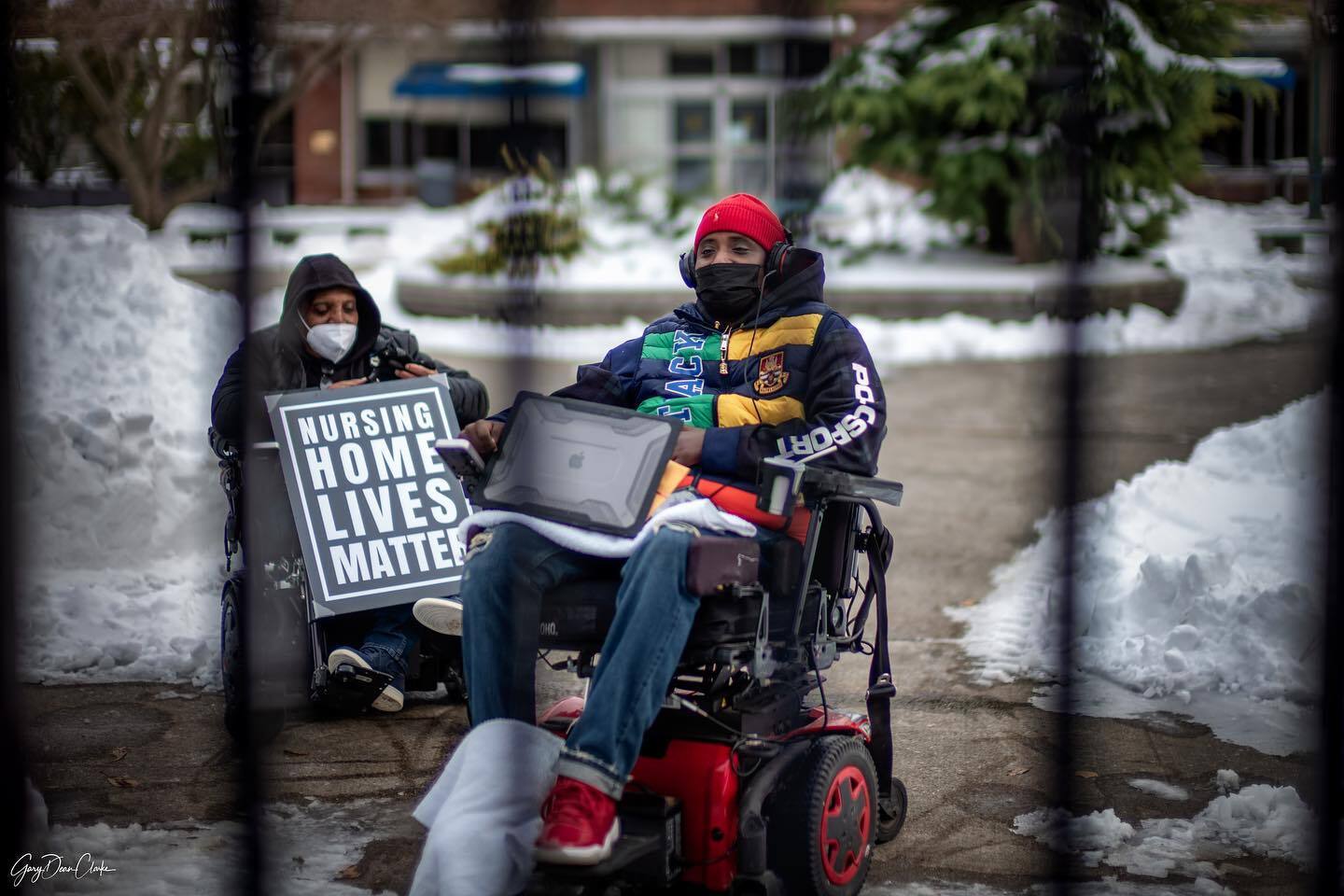
At the December 19 rally, Vincent Pierce (right) spoke to the media from inside Coler’s front gate. He is pictured here with fellow resident Peter Yearwood.
Gary Dean Clarke/@garydeanclarke
Eventually word got out that there were problems at this historic nursing home. The New York Post published an article describing Coler as a “nightmare” situation, with neglected patients covered in bedsores and living in rooms with feces smeared on the walls. A ProPublica investigation described refrigerated trailers parked out back of Coler serving as temporary morgues.
After weeks of negative press and pressure from the elected officials on Roosevelt Island who had been alerted to the problem, the NYC Health Department performed an official inspection on May 19, 2020. Its final report, entitled a “Complaint Survey”, stated that on May 19, between 10 a.m. and noon, 188 of the 485 full-time residents in 16 different units of Coler—or nearly 39 percent of those who lived here—tested positive. These residents were not being properly isolated from non-infected patients, the report noted, and shared rooms with others who were still healthy. Two days later, inspectors returned and found that 45 of the 188 COVID-19 positive residents had been isolated, but 143 of them were still sharing rooms with healthy patients.
Following the report, Coler implemented stricter testing and isolation policies, but there was never any follow-up on how many of those people died. When Coler residents started showing severe symptoms, they were removed and taken to hospitals like Bellevue for emergency treatment. “There’s a separate number who went to the hospital and died at the hospital,” said Coler CEO Robert Hughes during a virtual town hall event in late June. “COVID positive patients that went to the hospital and died is 11, he explained, and added that only one patient was what he called “COVID suspected.” Despite the high infection rates and the vulnerability of this population to the disease, Coler and NYC administrators continue to maintain that only 13 residents have died of COVID.
But how does one determine the real number of deaths? This is an issue that extends beyond Coler to nursing homes throughout New York—where COVID nursing home deaths have been undercounted since the beginning of the pandemic—and across the country. The New York City department of health decided early on that their tally of patient deaths would be based on the facility in which patients actually died in order to avoid “double counting” deaths in both nursing homes and hospitals, as New York health commissioner Howard Zucker explained in a legislative hearing that took place in early August 2020. It’s common protocol to transfer nursing home patients to hospitals in cases of acute medical conditions like, say, a COVID-19 emergency.
Investigations by various news outlets have shown that deaths were severely undercounted at the Isabella Geriatric Center in Washington Heights, the Riverdale Nursing Home in the Bronx, the Grand Rehabilitation and Nursing at Barnwell in Valatie, New York, and many other institutions. “It appeared they were sending people to the hospital so they wouldn’t die in the facility,” Jack Mabb, the Columbia County health director, told ProPublica regarding their investigation of the deaths at Grand Rehabilitation and Nursing at Barnwell. In addition to undercounting nursing home deaths because their residents technically died in hospitals, many nursing home residents have preexisting conditions, and before facilities started regular COVID-19 testing, it was hard to distinguish between those who died of COVID-19 and those who died of other comorbidities.
A New York Attorney General report released January 30, 2021, showed that based on ongoing investigations of 62 facilities, nursing homes’ deaths in New York state have been undercounted by as much as 50 percent. Though New York government data shows that only 13 COVID patients breathed last breath in Coler, it is likely that there were far more empty beds in Coler after COVID than this official count. The reality is we may never know how many Coler residents were among the total 443,751 fatalities from COVID-19. And those numbers matter because nursing homes like Coler are the eye of the coronavirus storm and suffered the greatest percentage of casualties. To plan for the remainder of this pandemic—or others like it—city administrators need to work from accurate data.
Vincent Pierce was initially a reluctant activist. In the first months of the pandemic, he refused to speak on the record to journalists about what was happening inside the nursing home. Eight months before he led demonstration in the snow outside Coler, he kept his head down.
He wasn’t the only one. When I first reported this story, most Coler residents were afraid to talk to me and unwilling to go on the record. Someone who is paraplegic or quadriplegic is almost completely dependent on the aides, nurses, physical therapists, and the entire professional infrastructure of the organization. These are the people who control when the resident can get out of their beds, when they eat, when they drink, when they bathe, and whether they’re able to enjoy “privileges” like using the media lab and going outside. Some who have spoken up were labeled as “troublemakers” and have been told they’ll get thrown out and forced into some other, potentially worse, living situation. Coler is a public nursing home in New York City that caters to a mostly low-income clientele. For many, the fear of losing their place is enough to discourage them from rocking the boat—or being perceived as the kind of person who does.
But after witnessing what Pierce regarded as horrible pandemic management on the part of the Coler administration—no rules for immediate social distancing, the lack of PPE, the lack of COVID patient isolation, the lies about COVID patients being moved into Coler, the dubious numbers of how many people died—Pierce decided to take action. In April, he started speaking out on behalf of the Coler residents about what they were experiencing. He was emboldened by the attention that Coler was receiving from the media and local politicians like Manhattan Borough President Gale Brewer, New York State Assembly member Rebecca Seawright, and New York State Senator José Serrano. People cared. Change seemed possible.
On June 25, 2020, Pierce participated in a virtual town hall organized by local elected officials to discuss the situation. Coler CEO Robert Hughes was also on the call. After about 11 minutes, Gale Brewer turned the floor over to Pierce. “I not only speak for myself,” Pierce began. “I speak for residents who cannot speak for themselves.” He went on to catalog everything he saw go wrong and then asked Hughes: “Why aren’t our voices heard or respected when we do speak up? Why did it take a piece in the New York Post from traveling nurses for them to finally start separating people? And how will it be different if [there] is a second wave?”
Hughes insisted that Coler staff had adequate PPE, and there was adequate staffing. What’s more, the administration was listening to residents’ concerns and testing 100 percent of the residents every week since the end of May. Hughes claimed that the reports of low PPE was due to a lack of education about when N95 respirators were actually necessary. He then acknowledged that as hard as the pandemic was for the staff, he couldn’t imagine how hard it was for the residents, whom he described as “not having access to information, hearing concerns, maybe observing what they think are concerns. One of the lessons learned from all of this is that, as occupied as we were in just dealing with the day-to-day and trying to make it as safe as possible for our residents…the communication access to our residents, and even to our staff for that matter, is something that needs to be improved upon.”
His response put Pierce over the edge.
“When you say we get the wrong information, how could you say we’re getting the wrong information when we’re living this, we’re seeing this?” Pierce replied. “We see that the nurses don’t have enough PPE to change from room to room. How can you say we’re getting wrong information when we’re locked down? We’re not seeing nobody else. This is something that we’re living through. How can you say we’re getting bad information?”
For Pierce, this meeting was the final straw and the catalyst for creating a petition that called for the immediate removal of Hughes. Pierce signed his name and encouraged others to do so as well.
Then George Floyd was killed by a police officer on May 25, and Pierce’s drive for change took on even greater urgency. He connected the police threat to Black lives with the threat from NYC H+H’s mishandling of the pandemic at Coler, which had endangered the majority Black and Brown residents and staff there.
Pierce says that before the media attention, the staff at Coler weren’t listening to residents when they reported nurse’s aides not wearing proper PPE, for instance, or not cleaning thoroughly, or when they said their roommates exhibited COVID symptoms. “We’re asking them to hear us out. We’re going through this, we’re living this, and you’re going home every day,” Pierce explains. “People are just trying to overlook us and treat us any type of way.” The risk of neglect is especially concerning for the residents who aren’t able to speak up for themselves because of physical or cognitive impairments, and those who are scared about jeopardizing the fragile lives they have established.
Pierce realized that he had a role to play in a movement that was bigger than him and bigger than Coler. A movement that was about the systematic disregard of Black pain among the medical establishment; the pulse oximeters that had a higher error rate in Black patients; the gaping disparity in COVID deaths based on race. He seized the momentum behind the “Voices of Coler” petition and founded the Nursing Home Lives Matter group as an offshoot of the Black Lives Matter protests. He connected with other disability activists liked the Essential Caregivers Coalition and lobbied at the New York state level to give residents the ability to choose an essential caregiver who will be allowed to visit residents at the home should a future pandemic strike.
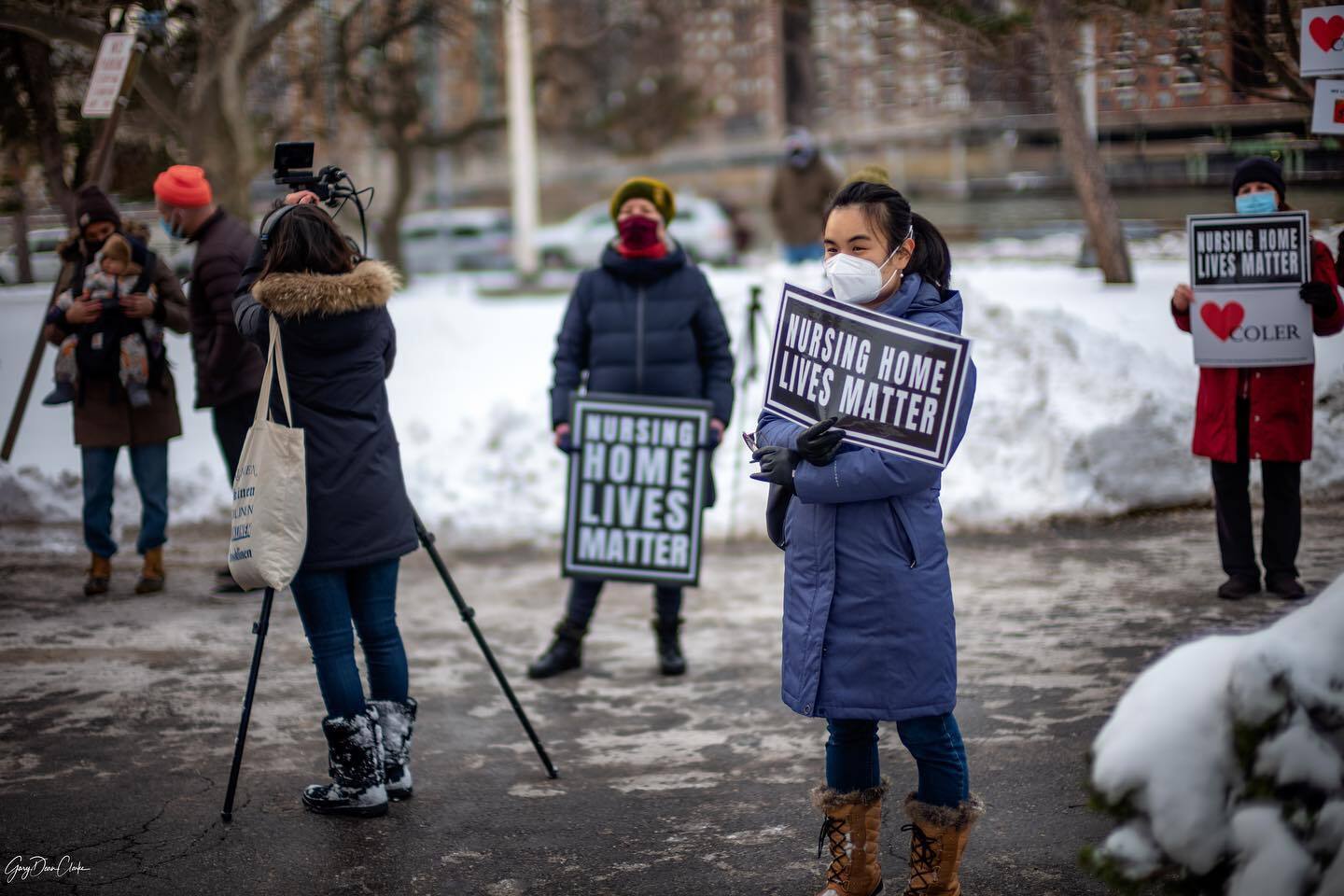
A crowd gathered outside Coler Nursing Home and Rehabilitation Center on Roosevelt Island for the launch of Nursing Home Lives Matter.
Gary Dean Clarke/@garydeanclarke
Pierce does acknowledge that Coler’s administration has made some significant improvements to the handling of infection since March. There’s the twice weekly COVID testing for staff and residents, and the conversion of four units on the C wing into isolation units for residents who have tested positive for the coronavirus and their roommates. He sees that the PPE shortages are no longer as severe for nurse’s aides, though he’s observed that not all aides wear KN95 masks and many have been wearing the same mask for multiple days in a row. Staffing shortages remain.
Then there are circumstances they have little control over. In pre-pandemic times, many residents would stay with their families on the weekends, have get-togethers in the courtyard, or hop on the bus and go into town if they were sufficiently mobile. But now all that relative freedom and mobility has been severely restricted. Since Coler staff keeps importing the coronavirus, rolling rounds of quarantine hit the floors, and residents are not only unable to leave the premises, but are isolated inside their rooms for two weeks at a time. The damaging effects of COVID inside this nursing home, as in so many others, is not simply the infection. Residents have suffered from the physical and psychological trauma of being confined to their rooms and their beds, watching their roommates and friends getting sick and disappearing around them.
While it’s too early to know the long-term mental health outcomes from all this isolation, there have been numerous past studies on how quarantines result in higher anxiety, depression, irritability, insomnia, the deterioration of cognitive abilities, and higher suicide rates among elderly people. Some mental health experts are anticipating lasting mental health impacts of COVID-19, describing them as the “fourth wave” of the pandemic. For Coler residents who have experienced periods of extreme isolation and whose lives are by definition constrained, the mental health repercussions are likely to be more severe.
“Social support and social connection is the strongest buffer against emotional challenges,” says Dr. Luana Marques, a clinical psychologist and researcher at the PRIDE Training Institute at Massachusetts General Hospital. “Nursing home residents are now isolated. Even the small social interactions they had have been limited, which can be petri dish for increased loneliness, depression, anxiety, and sadness.”
Ouslander too appreciates the serious psychological damage all this isolation is likely to impose on nursing home residents. Still, limiting the spread of the coronavirus must remain the top priority. “I’ve repeatedly said just don’t let your guard down, especially now with the new variants that are more contagious,” Ouslander tells me. “It’s really scary. It requires constant vigilance.”
At the event on December 19, as cameras from several TV stations were rolling, Pierce made an opening statement, but since he was restricted to being inside the fence, it was hard for others to hear him. Then Dexter Ciprian, a young organizer involved in Open Doors NYC, an art and advocacy network that originated with Coler residents, took over. He read a letter written by Manhattan Borough President Gale Brewer in which she asked NYC H+H not to move COVID patients into Coler again. He passed his megaphone to two wheelchair-bound former Coler residents. Taking turns, they read aloud anonymous testimonials about pandemic experiences from others who lived at Coler. One described the feeling of losing friends to COVID and missing loved ones:
“They used to call a code blue whenever someone was in a bad way, but after a while they stopped making the announcements. They didn’t want us to know, but you would hear people on their units. They would call and say, oh did you know so-and-so died, and that made you feel down and alone. I cried a lot. I couldn’t control myself with the crying. I was told there was going to be a memorial, but it wasn’t announced over the PA system. I feel bad because the people here are my family and I am missing them. I would have liked to acknowledge them.”
Another testimonial described what had happened as a cautionary tale:
“I have lived at Coler for over five years and have always felt safe here until this killer came to Coler, and all that was good about this place disappeared in the wink of an eye. One day I woke up and all my freedom was taken away. I was locked in with this monster who doesn’t discriminate. And my safe haven suddenly became a living hell. People were getting sick all around me, myself included. Even dying. I lost a couple of good friends and people that I knew… [W]e must do everything possible to not have a repeat of the first wave, and most of all, we must… try and stop the admission of COVID patients into Coler Nursing Home when there are so many at-risk patients. If I could speak to those people making these decisions I would have one question for them: Would you knowingly bring COVID patients into your home? Please don’t knowingly bring them into mine.”
In addition to the 50 or so people standing outside of Coler, over 500 tuned into the livestream on Facebook live.
Pierce had one objective: “We just wanted to make it known that this is a nursing home, it’s already vulnerable people here—we say no. We just want to make people understand that people in nursing homes’ lives matter,” he said. “They should be involved in the decision making that has anything to do with their quality of life.”
In one way, Pierce’s movement enjoyed its first victory that day. On the evening of the December 19 event, NYC H+H issued a statement saying that they have “no plans to open the Roosevelt Island Medical Center to respond to the current increase in COVID-19-related hospitalizations. NYC Health + Hospitals’ priority remains the safety of its patients, residents, and staff for the duration of the COVID-19 pandemic.
But the seeds of distrust between NYC H+H and Coler’s residents were already sown back in March, when they heard similar assurances. As the NYC infection rates hit a high in mid-January during what has been called “the dark winter of the pandemic,” and hospital occupancy rates feel the squeeze, residents still don’t feel safe despite the assurances from Hughes and NYC H+H CEO Mitchell Katz.
The high that Pierce felt after the success of his event in December was tempered by the grim realities of January. When I spoke to him in late January he was in the observation side of the COVID quarantine wing because his roommate had tested positive. He was quarantined for two weeks with forty to fifty other patients, many of them sick or on oxygen, with only one nurse on call for two sides of the unit. He said it could take 20 to 30 minutes for a nurse to answer calls for help. “It’s just bad right now,” he said. When we spoke he only had four days of quarantine left. He was getting through it by focusing on one day at a time. “I’m just occupying my mind, doing a lot of writing, watching movies, writing poetry,” he said. He told me he’s also started working on a memoir, hoping his words and activism will make a difference in how nursing home residents are treated.
“People care what we’re going through,” he told me. “It’s just the beginning.”
Catch Molly Schwartz in conversation with Vincent Pierce and his fellow Coler resident Andres “Jay” Molina on Thursday, February 4 at 7:00pm EST. Molina is the co-director of Fire Through Dry Grass, an upcoming documentary about the COVID-19 pandemic at Coler.
Correction: An earlier version of this story misstated that the Coler residents who rolled up to the gate at the rally are all paraplegic or quadriplegic. In fact, one has polio and another has a rare lung condition.
